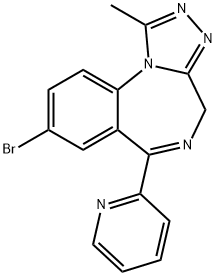Pyrazolam
- CAS NO.:39243-02-2
- Empirical Formula: C16H12BrN5
- Molecular Weight: 354.2
- MDL number: MFCD26954579
- EINECS: 200-258-5
- SAFETY DATA SHEET (SDS)
- Update Date: 2024-06-05 17:10:12

What is Pyrazolam?
Description
Pyrazolam (SH-I-04) is a benzodiazepine derivative originally developed by a team led by Leo Sternbach at Hoffman-La Roche in the 1970s. It has since been "rediscovered" and sold as a designer drug since 2012.
Pyrazolam has structural similarities to alprazolam and bromazepam. Unlike other benzodiazepines, pyrazolam does not appear to undergo metabolism, instead being excreted unchanged in the urine. It is most selective for the α2 and α3 subtypes of the GABAA receptor.
Chemical properties
Pyrazolam is a benzodiazepine that has been abused recreationally. Like other benzodiazepines, pyrazolam has anxiolytic effects.
The Uses of Pyrazolam
Pyrazolam is a benzodiazepine with an elimination half-life of about 17 hours and no detectable metabolites in human serum and urine; thus pyrazolam may go undetected without instrumental analytical techniques.
What are the applications of Application
Pyrazolam is a designer benzodiazepine that has been sold online as a 'legal high' or 'research chemical'. Since its emergence in Europe a few years ago, pyrazolam, along with other designer benzodiazepines, have increasingly been encountered in forensic case work.
Biological Activity
Pyrazolam has structural similarities to alprazolam and bromazepam. Unlike other benzodiazepines, pyrazolam does not appear to undergo metabolism, instead being excreted unchanged in the urine.It is most selective for the α2 and α3 subtypes of the GABAA receptor.
Pharmacology
Benzodiazepines produce a variety of effects by binding to the benzodiazepine receptor site and magnifying the efficiency and effects of the neurotransmitter gamma aminobutyric acid (GABA) by acting on its receptors. As this site is the most prolific inhibitory receptor set within the brain, its modulation results in the sedating (or calming effects) of pyrazolam on the nervous system.The anticonvulsant properties of benzodiazepines may be, in part or entirely, due to binding to voltage-dependent sodium channels rather than benzodiazepine receptors.Pyrazolam is most selective for the α2 and α3 receptor subtypes. It is excreted by the body unchanged thus not interacting with liver enzymes like other benzodiazepines, meaning that its use in people with reduced liver function may be safer.
Properties of Pyrazolam
| Melting point: | 253-255 °C |
| Boiling point: | 544.4±60.0 °C(Predicted) |
| Density | 1.62±0.1 g/cm3(Predicted) |
| storage temp. | -20°C |
| solubility | DMF: 30 mg/ml; DMF:PBS(pH 7.2)(1:1): 0.5 mg/ml; DMSO: 20 mg/ml; Ethanol: 10 mg/ml; Methanol: 1 mg/ml |
| form | A crystalline solid |
| pka | 2.18±0.40(Predicted) |
| InChI | InChI=1S/C16H12BrN5/c1-10-20-21-15-9-19-16(13-4-2-3-7-18-13)12-8-11(17)5-6-14(12)22(10)15/h2-8H,9H2,1H3 |
Safety information for Pyrazolam
Computed Descriptors for Pyrazolam
| InChIKey | BGRWSFIQQPVEML-UHFFFAOYSA-N |
| SMILES | N12C(C)=NN=C1CN=C(C1=NC=CC=C1)C1=CC(Br)=CC=C12 |
New Products
4-AMINO-TETRAHYDRO-PYRAN-4-CARBOXYLIC ACID HCL 4-(Dimethylamino)tetrahydro-2H-pyran-4-carbonitrile 4-AMINO-TETRAHYDRO-PYRAN-4-CARBOXYLIC ACID 4-Aminotetrahydropyran-4-carbonitrile Hydrochloride (R)-3-Aminobutanenitrile Hydrochloride 5-Bromo-2-nitropyridine Nimesulide BP Aceclofenac IP/BP/EP Diclofenac Sodium IP/BP/EP/USP Mefenamic Acid IP/BP/EP/USP Ornidazole IP Diclofenac Potassium 3-Bromopyrazole (3aR,4R,5R,6aS)-hexahydro-5-Triethyl silyloxy-4-((E)-3-oxo-5-phenylpent-1- enyl)cyclopenta[b]furan-2-one. 1-Chlorocarbonyl-4-piperidinopiperidine 1-Bromo-4-phenyl-2-Butanone 4-Amino-2-fluoro-N-methylbenzamide 1,1'-Carbonyldiimidazole SODIUM AAS SOLUTION ZINC AAS SOLUTION BUFFER SOLUTION PH 10.0(BORATE) GOOCH CRUCIBLE SINTERED AQUANIL 5 BERYLLIUM AAS SOLUTIONRelated products of tetrahydrofuran
You may like
-
![Dimethyl [2-oxo-3-[3-(trifluoromethyl)phenoxy]propyl]phosphonate 99%](https://img.chemicalbook.in//Content/image/CP5.jpg) Dimethyl [2-oxo-3-[3-(trifluoromethyl)phenoxy]propyl]phosphonate 99%View Details
Dimethyl [2-oxo-3-[3-(trifluoromethyl)phenoxy]propyl]phosphonate 99%View Details
54094-19-8 -
 85-81-4 99%View Details
85-81-4 99%View Details
85-81-4 -
 Cyclopentane carboxxylic acid 3400-45-1 99%View Details
Cyclopentane carboxxylic acid 3400-45-1 99%View Details
3400-45-1 -
![208111-98-2 (3aR,4R,5R,6aS)-5-(Benzoyloxy)hexahydro-4-[(1E)-3-oxo-4-[3-(trifluoromethyl)phenoxy]-1-buten- 1-yl]-2H-cyclopenta[b]furan-2-one 99%](https://img.chemicalbook.in//Content/image/CP5.jpg) 208111-98-2 (3aR,4R,5R,6aS)-5-(Benzoyloxy)hexahydro-4-[(1E)-3-oxo-4-[3-(trifluoromethyl)phenoxy]-1-buten- 1-yl]-2H-cyclopenta[b]furan-2-one 99%View Details
208111-98-2 (3aR,4R,5R,6aS)-5-(Benzoyloxy)hexahydro-4-[(1E)-3-oxo-4-[3-(trifluoromethyl)phenoxy]-1-buten- 1-yl]-2H-cyclopenta[b]furan-2-one 99%View Details
208111-98-2 -
 2033-24-1 99%View Details
2033-24-1 99%View Details
2033-24-1 -
 Meldrums acid 2033-24-1 99%View Details
Meldrums acid 2033-24-1 99%View Details
2033-24-1 -
 Cyaclopentane carboxylic acid 99%View Details
Cyaclopentane carboxylic acid 99%View Details
3400-45-1 -
 2-Aminopyridine 504-29-0 99%View Details
2-Aminopyridine 504-29-0 99%View Details
504-29-0
![1H-Pyrrolo[2,3-c]pyridin-7-amine(9CI)](https://img.chemicalbook.in/CAS/GIF/165669-36-3.gif)
![PYRAZOLO[1,5-A]PYRIMIDINE](https://img.chemicalbook.in/CAS/GIF/274-71-5.gif)